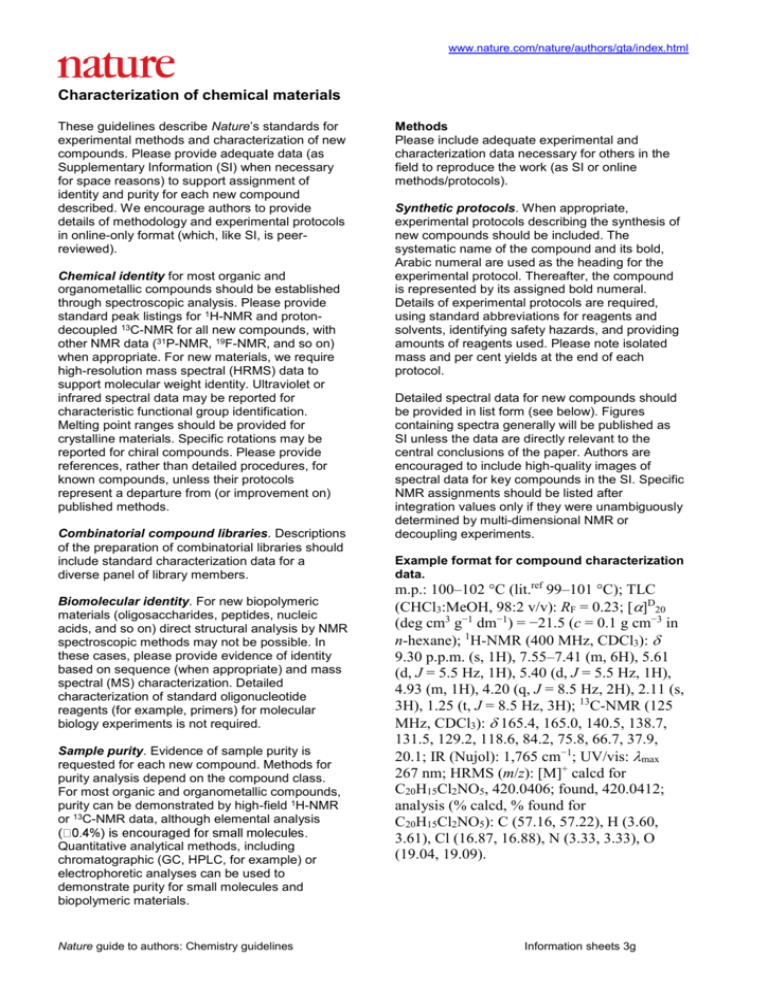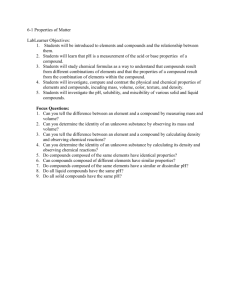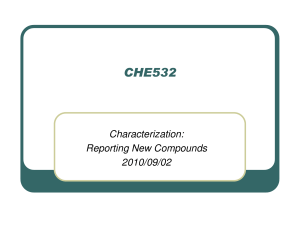Characterization of chemical materials
advertisement

www.nature.com/nature/authors/gta/index.html Characterization of chemical materials These guidelines describe Nature’s standards for experimental methods and characterization of new compounds. Please provide adequate data (as Supplementary Information (SI) when necessary for space reasons) to support assignment of identity and purity for each new compound described. We encourage authors to provide details of methodology and experimental protocols in online-only format (which, like SI, is peerreviewed). Chemical identity for most organic and organometallic compounds should be established through spectroscopic analysis. Please provide standard peak listings for 1H-NMR and protondecoupled 13C-NMR for all new compounds, with other NMR data (31P-NMR, 19F-NMR, and so on) when appropriate. For new materials, we require high-resolution mass spectral (HRMS) data to support molecular weight identity. Ultraviolet or infrared spectral data may be reported for characteristic functional group identification. Melting point ranges should be provided for crystalline materials. Specific rotations may be reported for chiral compounds. Please provide references, rather than detailed procedures, for known compounds, unless their protocols represent a departure from (or improvement on) published methods. Combinatorial compound libraries. Descriptions of the preparation of combinatorial libraries should include standard characterization data for a diverse panel of library members. Biomolecular identity. For new biopolymeric materials (oligosaccharides, peptides, nucleic acids, and so on) direct structural analysis by NMR spectroscopic methods may not be possible. In these cases, please provide evidence of identity based on sequence (when appropriate) and mass spectral (MS) characterization. Detailed characterization of standard oligonucleotide reagents (for example, primers) for molecular biology experiments is not required. Sample purity. Evidence of sample purity is requested for each new compound. Methods for purity analysis depend on the compound class. For most organic and organometallic compounds, purity can be demonstrated by high-field 1H-NMR or 13C-NMR data, although elemental analysis Quantitative analytical methods, including chromatographic (GC, HPLC, for example) or electrophoretic analyses can be used to demonstrate purity for small molecules and biopolymeric materials. Nature guide to authors: Chemistry guidelines Methods Please include adequate experimental and characterization data necessary for others in the field to reproduce the work (as SI or online methods/protocols). Synthetic protocols. When appropriate, experimental protocols describing the synthesis of new compounds should be included. The systematic name of the compound and its bold, Arabic numeral are used as the heading for the experimental protocol. Thereafter, the compound is represented by its assigned bold numeral. Details of experimental protocols are required, using standard abbreviations for reagents and solvents, identifying safety hazards, and providing amounts of reagents used. Please note isolated mass and per cent yields at the end of each protocol. Detailed spectral data for new compounds should be provided in list form (see below). Figures containing spectra generally will be published as SI unless the data are directly relevant to the central conclusions of the paper. Authors are encouraged to include high-quality images of spectral data for key compounds in the SI. Specific NMR assignments should be listed after integration values only if they were unambiguously determined by multi-dimensional NMR or decoupling experiments. Example format for compound characterization data. m.p.: 100–102 °C (lit.ref 99–101 °C); TLC (CHCl3:MeOH, 98:2 v/v): RF = 0.23; []D20 (deg cm3 g−1 dm−1) = −21.5 (c = 0.1 g cm−3 in n-hexane); 1H-NMR (400 MHz, CDCl3): 9.30 p.p.m. (s, 1H), 7.55–7.41 (m, 6H), 5.61 (d, J = 5.5 Hz, 1H), 5.40 (d, J = 5.5 Hz, 1H), 4.93 (m, 1H), 4.20 (q, J = 8.5 Hz, 2H), 2.11 (s, 3H), 1.25 (t, J = 8.5 Hz, 3H); 13C-NMR (125 MHz, CDCl3): 165.4, 165.0, 140.5, 138.7, 131.5, 129.2, 118.6, 84.2, 75.8, 66.7, 37.9, 20.1; IR (Nujol): 1,765 cm−1; UV/vis: max 267 nm; HRMS (m/z): [M]+ calcd for C20H15Cl2NO5, 420.0406; found, 420.0412; analysis (% calcd, % found for C20H15Cl2NO5): C (57.16, 57.22), H (3.60, 3.61), Cl (16.87, 16.88), N (3.33, 3.33), O (19.04, 19.09). Information sheets 3g www.nature.com/nature/authors/gta/index.html Crystallographic data for small molecules. Manuscripts reporting new three-dimensional structures of small molecules from crystallographic analysis should include a structural figure with probability ellipsoids and a .cif file. Please deposit small molecular crystallographic data in the Cambridge Structural Database (http://www.ccdc.cam.ac.uk), and provide accession numbers. Full access must be provided on publication. Nomenclature and abbreviations We strongly prefer, but do not insist on, systematic nomenclature for chemical compounds and biomolecules, using IUPAC and IUBMB rules (http://www.chem.qmw.ac.uk/iupac). Standard chemical and biological abbreviations should be used, with unconventional and specialist abbreviations defined at first use. Chemical structure display items Figures containing chemical structures should be produced using ChemDraw or a similar program, and submitted in a size appropriate for the printed page. Assign all chemical compounds a bold, Arabic numeral in the order in which the compounds are presented in the main text. When using ChemDraw, set the following preferences and submit the files at 100%. Drawing settings: chain angle, 120°; bond spacing, 18% of width; fixed length, 14.4 pt; bold width, 2.0 pt; line width, 0.6 pt; margin width 1.6 pt; hash spacing 2.5 pt. Text settings: font, Arial or Helvetica; size, 10 pt. Preferences: units, points; tolerances, 3 pixel. Formats Please note that we cannot process ChemDraw files. Chemical structure files should be saved into .eps format, or another acceptable format as described at: http://www.nature.com/nature/authors/submissions /final/Final_artwork.pdf. Nature guide to authors: Chemistry guidelines Information sheets 3g






